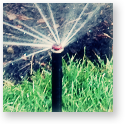Residential Sales
Save Money on Water
Approximately 80% of all homes in the United States have grass lawns. This has resulted in a $40 billion per year industry, with American grass lawns using more water than is used to grow all the wheat and corn in the United States. In that sense, by water consumption, grass is the United States’ leading “crop” by far, with the Environmental Protection Agency estimating that about 1/3 of all public water is used to water grass, with that number rising as high as 70% in some of the more dry regions of the United States.
“Why We Have Grass Lawns” – Emily Upton article, 3/5/2014
SAVING WATER IS THE BEST WAY TO SAVE MONEY
According to a 2014 report from CNBC, water bills are rising and will likely continue to do so. Many factors are involved in the increase, but in the Chicago area, domestic water rates are on the increase for the city and many suburbs that use mainlines from the City of Chicago. The increase was put in place to update infrastructure and repair or replace water main lines, some of which are over 100 years old.
Using a sprinkler system can be an effective way to use and manage water wisely when installed and managed properly. Below are some methods, techniques and considerations that Naturescape Irrigation service teams and installers implement when working at a site:
1.
Attention to proper installation.
The most vulnerable parts of the irrigation system are all the connection points that tie the system together. Keeping the system running efficiently saves money on both water and repairs.
The junction of valves to mainline are rigidly installed to ensure that there is no damage from the water hammer effect that moving water creates. This technique will ensure the longevity of the valves and connection points.
Wires are spliced together and encased in a waterproof container to prevent corrosion to deteriorate splice points and the integrity of the communication path for zone control. Sprinkler heads are installed so that they are able to move with the expansion and contraction of the soils. This diminishes having to reset heads over the years to ensure zone coverage is staying true to design. Using pressure regulating heads ensures that the zones have even pressure throughout the zone during operation, maximizing water use efficiency.
2.
Encouraging regular inspections of the system.
This helps ensure that the system is operating up to the design specifications. Repairing 1 broken spray head will save 10 gallons of water per minute; repairing 1 broken rotor will save 20 gallons of water per minute.
3.
Checking controllers and weather monitors.
Recent technology improvements in controller units and weather sensors make the irrigation system work with the local and regional environmental conditions effectively. The savings for updating the controller can be up to 8,800 gallons per year. Weather sensors have become more capable of collecting data in regards to moisture, wind and solar radiation thus enabling the irrigation system to have an annual savings of 35%. Soil moisture sensors continuously monitor soil conditions to make the watering schedule more effective saving up to 35% in annual water savings. Understanding plant, soil and water relationships and coordinating with these devices so that complete saturation and/or a permanent wilting point does not place undue stress on the plant material.
A properly designed, installed, maintained and scheduled irrigation system will promote plant and soil heath along with reducing the need for over fertilizing plants due to run off. Along with the obvious run off issues, the irrigation system will also use the water effectively by not taxing the water way system and or the aquafer that has a well tied to it. Utilizing water when needed for the plant material in supplemental times will allow aquafers, ponds and lakes to fill for times of real need and not diminish the ecology to the areas in which water is removed. Allowing the growth of root systems with the right amount of watering will establish a landscape that, when mature, will be less and less dependent on the irrigation system. Ultimately, by taking actions on the issues noted above, Naturescape Irrigation customers will save on their water bill by conserving their overall water usage.
Calculating H2O Use
Sourced from The University of Missouri's Home Lawn Watering Guide.
If a sprinkler delivers 1/4 inch of water in 45 minutes, then how much water does it apply in 1 hour (60 minutes)?

An alternative approach would be to measure the area that your sprinkler pattern covers and the length of time it takes to fill a one-gallon container directly from the sprinkler. Example 2 describes how to calculate your water application rate using this approach.
If a sprinkler takes 1 minute and 13 seconds (73 seconds) to discharge 1 gallon of water, then how many gallons of water can it discharge in 1 hour (3,600 seconds)?

If 49 gallons of water is applied to 235 square feet per hour, then how many gallons are applied to 1,000 square feet in 1 hour?

If 624 gallons of water equals 1 inch of water per 1,000 square feet, then how many inches of water will 208 gallons of water provide per 1,000 square feet?

In the above examples, sprinklers should be operated about three hours in each location to supply 1 inch of irrigation water per week.
The utility water meter connected to your home can also be used to check how effectively water is being applied. It accurately measures water in cubic feet. When no other water is being used in the home, water a known area for a set amount of time, and use these conversion factors to determine your water application rate:
- 624 gallons (83.3 cubic feet) of water are required to apply 1 inch of water on 1,000 square feet of lawn.
- 7.48 gallons = one cubic foot of water.
Approximate lawn water requirements:
| Lawn Type | Green Turf 1 | Dormant Turf 2 |
|---|---|---|
| Perennial ryegrass | 1.5 inches of water per week | 1.0 inches of water per week |
| Kentucky bluegrass | 1.2 inches of water per week | 0.7 inches of water per week |
| Tall fescue | 0.8 inches of water per week | 0.5 inches of water per week |
| Zoysia or bermuda | 0.5 inches of water per week | 0.2 inches of water per week |
| Buffalo grass | 0.3 inches of water per week | 0.2 inches of water per week |
1 Lawn remains green and growing
2 Lawn may turn brown, but will not die



